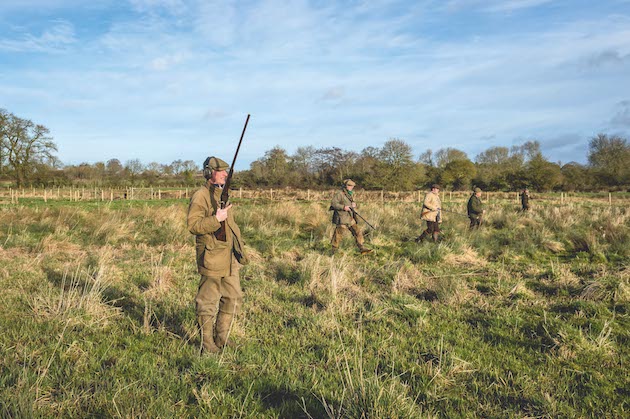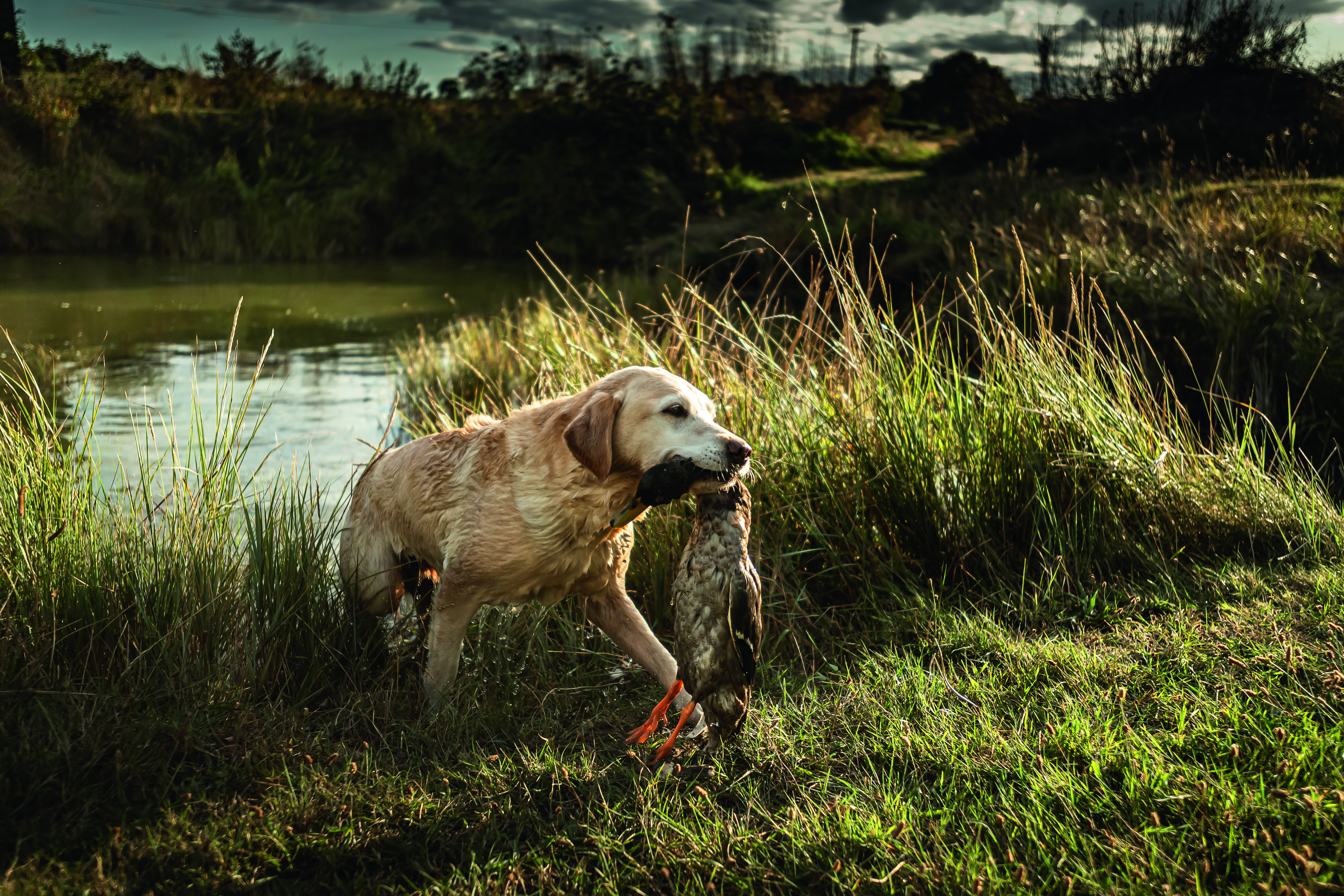Win CENS ProFlex DX5 earplugs worth £1,149 – enter here
How to bag rough shooting
 Starting to walk the marsh full of snipe, L to R: Simon Reinhold, Richard MaCmallen, John Ebbage,
Usd 29 Jan 20 rough shoot
Starting to walk the marsh full of snipe, L to R: Simon Reinhold, Richard MaCmallen, John Ebbage,
Usd 29 Jan 20 rough shoot
On my desk as I write this is a rather yellowed and crumpled letter from the Forestry Commission offering an annual shooting lease over 1,003 acres at West Tofts, Norfolk, for the princely sum of £50. The letter is dated November 1971, a time when my father and a group of his friends were looking for a new piece of ground to shoot over and had contacted the Commission in the hope that a rough shooting permission might be available in or around Thetford Forest.
They took the lease. I remember accompanying my father on several days walking-up the edges of the big forest rides and hunting out the odd wild pheasant, pigeon or rabbit as we did so. Game was scarce, bags were small, but what fun we had.
Fifty years ago, it was not difficult to track down the opportunity for a little casual shooting. The fashion for shooting driven game had not yet taken off and outside of the traditional estate shoots, few people reared pheasants or partridges. Such farm shoots as there were relied upon wild birds which were usually walked-up from what seemed to me at the time to be endless acres of sugar beet.
Some clubs own their land and offer members a mix of sport, from snipe to duck and rabbits
A rough shooting permission
How things have changed. Nowadays, following the development of the game rearing industry and of game crops in which to release and hold birds, there are literally thousands of farm shoots all over the country.
And with the increased interest that there is in game shooting, the chance of lighting upon a quiet piece of farmland in which to hunt a few hedgerow pheasants and bowl over the odd rabbit of an autumn evening is much less than it once was.
But though difficult, it is by no means impossible, in some parts of the country at least, to secure a small rough shoot. Granted, competition is tough if you are within striking distance of a big city, but in the remoter, more rural parts of the UK, the chances are still there.
That is particularly the case where farms are small and owner-occupied. The owner of a small patch of 50 or 100 acres, perhaps with small fields and thick, unkempt hedges, is more likely to be willing to respond to a thoughtfully considered approach than the larger, more organised farmer who may well be running his own shoot already. So in small farm country like the Welsh borders, the West Country and south-west Scotland, especially if you know your locality or have strong family connections, there are useful opportunities for those who are prepared to seek them out.
Conversely, in a district of large sporting estates where shooting rights are retained by the landowner, the tenant farmer is unlikely to be able to offer anything beyond permission to control rabbits and pigeon.
A district of large shoots, however, has its own opportunities as there will be a well-established network of gamekeepers who will often be on the lookout for regular, reliable beaters.
Matthew Stafford
Local shooting grapevine
There is no better way of tapping into the local shooting grapevine than getting to know those who turn out throughout the season in the beating line. The reward for a season’s beating will usually be an invitation to the beaters’ day and quite likely some pigeon or rabbit shooting as well. But among the beating team will be pigeon shooters, rough shooters and wildfowlers who will often have their own little patches of rough shooting permission and may be prepared to offer intelligence on local opportunities that might exist, or even share it with someone who is willing to help out with costs or work.
It takes time and trust to develop contacts like these. But getting on to the local shooting network may be one of the best stepping stones towards acquiring some simple sporting opportunity. Another is to join a club. Coastal wildfowling clubs also have some inland shooting permissions or leases where it is possible to enjoy anything from walked-up rabbit shooting to even the chance of shooting the odd pheasant.
Remember that a fair proportion of wildfowling clubs these days are landowners in their own right and will have gamebirds on their ground as well as the more traditional duck and geese.
My own club, for instance, has shooting areas where members can hunt the bracken and brambles for the odd rabbit, chase a marsh pheasant, flush a woodcock or snipe, and even join a more or less organised walk-up once a month. It is by no means alone in this, and enjoying a pint and a yarn at the end of a club meeting — and I am sufficiently optimistic to think that wildfowling club meetings in pub bars will happen again before too long — has opened the door to many a day’s rough shooting.

In time you may be invited to share a permission for exchange for help with costs or work
Offer to control pests
If your work takes you around the fringes of the farming industry, whether in contracting, machinery sales or some other aspect of agriculture, then you are at a distinct advantage, for you will most likely be meeting farmers on a regular basis. But even then, few will respond positively to a request for rough shooting unless they know you well.
An offer to control pests is perhaps a different matter. Though rabbits are not as plentiful as they were a few years ago, they are still a problem for both the arable and the livestock farmer. Pigeon likewise, especially where there is oilseed rape to be protected in late winter, and a well-researched, considered and polite request may bear fruit.
Where it does, and where it leads to the establishment of trust, it can lead to greater things. Perhaps even an agreement to shoot wild game in the hedgerows and spinneys around the farm. There will need to be something in it for the farmer. Usually that will be a reasonable rent, but in one case that I remember, the farmer consented to allowing the development of a small DIY game shoot on his land in which he shared the chores on the basis of a modest rent and the opportunity both to shoot and invite some guests each season. All this came from a friendly approach by someone who had done his homework and had a bit of vision.
Building trust with a farmer may well see further sporting opportunities come your way
That was a few years ago. Today, farming is on the cusp of huge changes as the Common Agricultural Policy’s basic payment scheme is exchanged for new, environment-led farm support. The planting of hundreds of small woods and spinneys across the country, the creation of rough field margins and wildlife ponds and the establishment of new wild bird or pollen and nectar mixes all make ever more space for game and wildlife.
Such things will be part and parcel of the new environmental grant scheme that will in future support agriculture, and there is every chance that they will create exciting new shooting opportunities where none existed before. Meanwhile, smaller farmers in particular may well be keen to eke out their diminished incomes with a modest shooting rent. So maybe it is now time to look again for that little rough shooting permission.
Related Articles
Get the latest news delivered direct to your door
Subscribe to Shooting Times & Country
Discover the ultimate companion for field sports enthusiasts with Shooting Times & Country Magazine, the UK’s leading weekly publication that has been at the forefront of shooting culture since 1882. Subscribers gain access to expert tips, comprehensive gear reviews, seasonal advice and a vibrant community of like-minded shooters.
Save on shop price when you subscribe with weekly issues featuring in-depth articles on gundog training, exclusive member offers and access to the digital back issue library. A Shooting Times & Country subscription is more than a magazine, don’t just read about the countryside; immerse yourself in its most authoritative and engaging publication.







